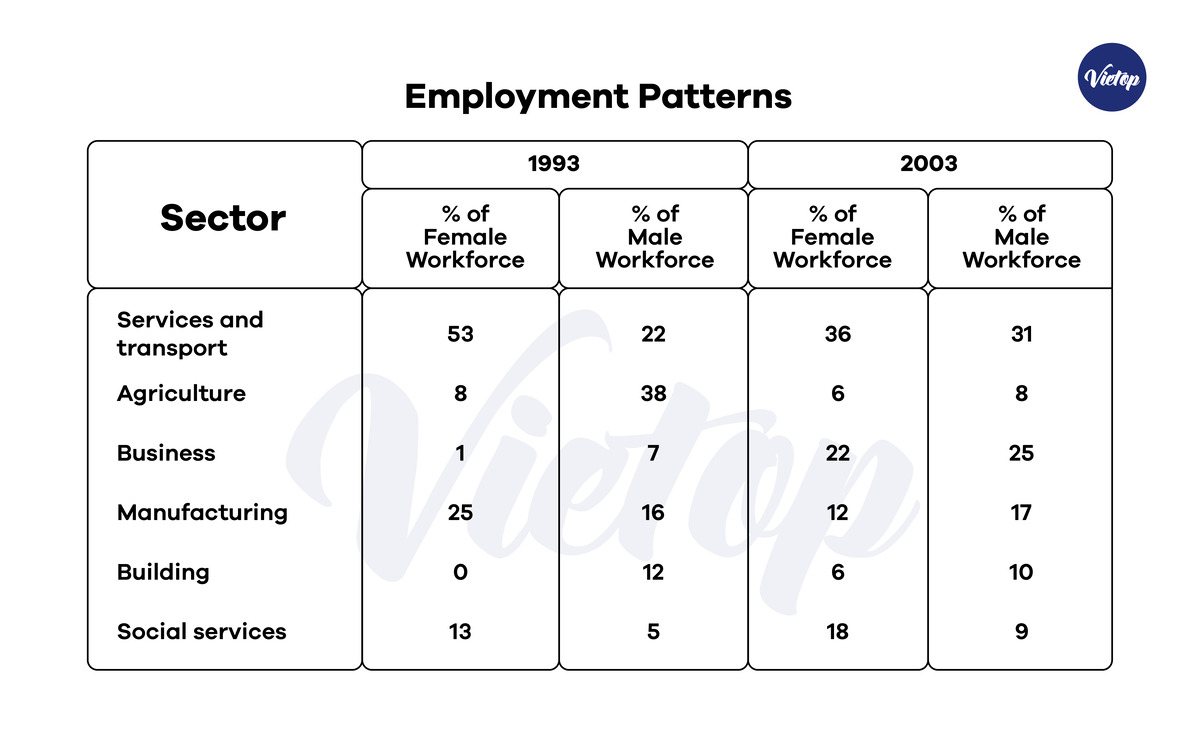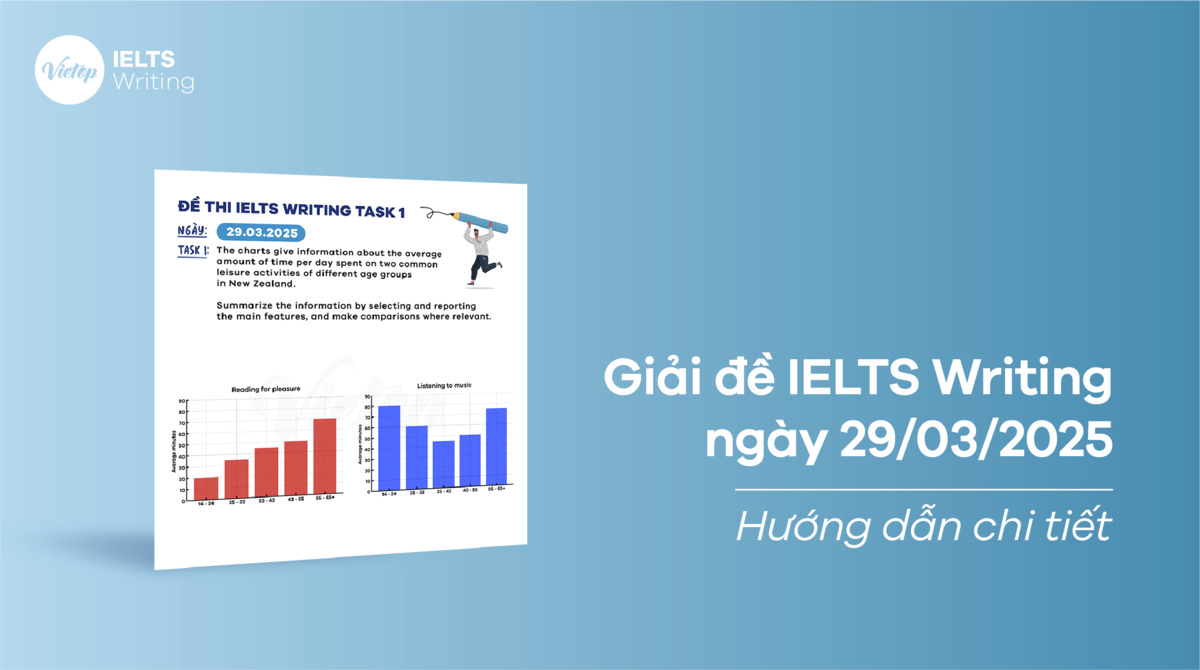Trong kỳ thi IELTS ngày 22/03/2025, phần Writing gồm hai dạng bài: Bảng số liệu (Table) ở Task 1 và thảo luận hai quan điểm (Discuss both views) ở Task 2. Theo mình đánh giá, cả hai đề lần này đều khá thử thách và đòi hỏi thí sinh phải có kỹ năng phân tích và lập luận tốt.
Cụ thể, đề bài như sau:
- Đề IELTS Writing Task 1: The table below shows employment patterns for males and females in New Zealand in 1993 and 2003. Summarize the information by selecting and reporting the main features, and make comparisons where relevant.
- Đề IELTS Writing Task 2: Many companies today sponsor sports as a way of advertising themselves. Some people think that this is a good thing for the world of sports. Others think this has disadvantages. Discuss both these views and give your own opinion.
Trong bài giải đề IELTS Writing ngày 22/03/2025, mình sẽ hướng dẫn bạn cách tiếp cận dạng bài này một cách hiệu quả – từ việc phân tích đề, lên dàn ý cụ thể đến vận dụng các chiến lược viết giúp bài làm rõ ràng, logic và thuyết phục hơn. Qua đó, bạn sẽ tự tin hơn và nâng cao khả năng đạt được band điểm như kỳ vọng!
Cùng mình học bài thôi!
1. IELTS Writing Task 1
| The table below shows employment patterns for males and females in New Zealand in 1993 and 2003. Summarize the information by selecting and reporting the main features, and make comparisons where relevant. |
| (Bảng dưới đây thể hiện xu hướng việc làm của nam và nữ tại New Zealand vào các năm 1993 và 2003. Hãy tóm tắt thông tin bằng cách chọn lọc và trình bày những đặc điểm nổi bật, đồng thời đưa ra các so sánh phù hợp.) |

1.1. Bước 1: Phân tích đề
- Dạng biểu đồ: Table
- Topic: Tình hình việc làm của nam và nữ ở New Zealand trong các ngành công nghiệp/ dịch vụ vào năm 1993 và năm 2003
- Number of factors: N/A
- Time: Năm 1993, năm 2003
- Tense: Các thì quá khứ
- Nhóm dữ liệu: Nhóm theo ngành
- Body paragraph 1: Các ngành có xu hướng tăng (Business và Social services)
- Body paragraph 2: Các ngành có xu hướng giảm hoặc giữ nguyên (Services and transport, Agriculture, Manufacturing, và Building)
- => Bài viết có 2 đoạn thân bài
1.2. Bước 2: Lập dàn ý
Introduction: Paraphrase đề bài.
Overview:
- Business saw the most notable growth for both genders.
- Agriculture declined significantly, especially among men.
- Some gender-specific sectors remained stable, while others experienced shifts.
| Body paragraph 1: sectors with growth | Body paragraph 2: Male workforce trends |
| – Business: Significant increase for both men and women. – Social Services: Moderate growth, especially for women. | – Agriculture: Major decline, especially for men. – Services and Transport: Female employment dropped; male employment increased. – Manufacturing: Female decline, male stable. – Building: Remained male-dominated; slight drop for men, minor rise for women. |
1.3. Bước 3: Bài mẫu
1.3.1. Bài mẫu band 5.0+
The table show the percentage of men and women who work in six areas in New Zealand in 1993 and 2003.
We can see that some of the number go up and some go down in ten years. In general, men and women work in different place, and the numbers change in some of the jobs.
For women, the biggest number was in services and transport in 1993, with 53%. But in 2003 it go down to 36%. Also, business for women grow from 1% to 22%. Social service also go up, from 13 to 18. In agriculture and manufacturing, the numbers go down. Building was low in both year.
For men, the biggest change is in agriculture. In 1993 it was 38% and then go down to 8%. Business also grow from 7 to 25. Social service is more also. Building and manufacturing not change much. Services and transport go up a bit.
1.3.2. Bài mẫu band 7.5+
The table provides information about the percentage of male and female workers in six different employment sectors in New Zealand in 1993 and 2003.
Overall, business experienced the most significant growth in employment for both genders, while agriculture saw a notable decline, particularly among men. Although some traditionally gendered sectors remained consistent, others showed a shift in gender balance or popularity over time.
Employment in business and social services increased across the board. In business, the share of female workers rose dramatically from 1% in 1993 to 22% in 2003, while the male figure jumped from 7% to 25%, making it the most popular sector for men by the end of the period. Similarly, social services saw moderate growth, especially among women, rising from 13% to 18%, while male employment in that field almost doubled from 5% to 9%.
In contrast, agriculture experienced a steep decline, particularly for males, whose employment dropped from 38% to just 8%. Female participation in agriculture remained low, decreasing slightly from 8% to 6%. A shift was also observed in services and transport, where female employment fell sharply from 53% to 36%, while the male proportion increased from 22% to 31%. Manufacturing remained relatively stable for men (16% to 17%) but saw a decline for women (25% to 12%). The building sector stayed male-dominated throughout the period, with a slight drop from 12% to 10%, and only a minor rise in female participation to 6%.
1.4. Từ vựng
| Từ vựng | Nghĩa |
| Traditionally gendered sectors /trəˈdɪʃənəli ˈdʒɛndɚd ˈsɛktərz/ | (noun phrase (collocation) các ngành nghề mang tính chất giới truyền thống E.g. Women are increasingly entering traditionally gendered sectors like construction and engineering. (Phụ nữ ngày càng tham gia vào các ngành nghề mang tính chất giới truyền thống như xây dựng và kỹ thuật.) |
| Gender balance /ˈdʒɛndɚ ˈbæləns/ | (noun phrase (collocation)) sự cân bằng giới tính E.g. Promoting gender balance in leadership positions is a key priority. (Thúc đẩy sự cân bằng giới tính trong các vị trí lãnh đạo là ưu tiên hàng đầu.) |
| Increase across the board /ɪnˈkriːs əˈkrɔs ðə bɔːrd/ | (verb phrase (collocation)) tăng đồng loạt, tăng trên mọi phương diện E.g. Wages have seen an increase across the board in the public sector. (Mức lương đã tăng đồng loạt trong khu vực công.) |
| Rise dramatically /raɪz drəˈmætɪkli/ | (verb phrase (collocation)) tăng mạnh E.g. Female participation in STEM fields has risen dramatically in recent years. (Sự tham gia của nữ giới trong các lĩnh vực STEM đã tăng mạnh trong những năm gần đây.) |
| See moderate growth /siː ˈmɒdərət ɡroʊθ/ | (verb phrase (collocation)) chứng kiến sự tăng trưởng vừa phải E.g. The education sector has seen moderate growth over the last decade. (Ngành giáo dục đã chứng kiến sự tăng trưởng vừa phải trong thập kỷ qua.) |
| Male employment /meɪl ɪmˈplɔɪmənt/ | (noun phrase (collocation)) việc làm của nam giới E.g. Male employment in manufacturing has declined significantly. (Việc làm của nam giới trong ngành sản xuất đã giảm đáng kể.) |
| Experience a steep decline /ɪkˈspɪriəns ə stiːp dɪˈklaɪn/ | (verb phrase (collocation)) trải qua một sự suy giảm mạnh E.g. The textile industry experienced a steep decline in employment. (Ngành dệt may đã trải qua một sự suy giảm mạnh về việc làm.) |
| Male-dominated /ˈmeɪl ˈdɑːmɪneɪtɪd/ | (adjective) nam giới chiếm đa số E.g. Engineering is often viewed as a male-dominated field. (Kỹ thuật thường được xem là một lĩnh vực do nam giới chiếm đa số.) |
Xem thêm:
- [ACE THE TEST] Giải đề IELTS Writing ngày 08/03/2025
- [ACE THE TEST] Giải đề IELTS Writing ngày 06/03/2025
- [ACE THE TEST] Giải đề IELTS Writing ngày 22/02/2025
- Tổng hợp đề thi IELTS Writing 2025 kèm bài mẫu chi tiết
2. IELTS Writing Task 2
| Many companies today sponsor sports as a way of advertising themselves. Some people think that this is a good thing for the world of sports. Others think this has disadvantages. Discuss both these views and give your own opinion. |
| (Ngày nay, nhiều công ty tài trợ cho các môn thể thao như một cách để quảng bá thương hiệu của mình. Một số người cho rằng điều này mang lại lợi ích cho lĩnh vực thể thao, trong khi những người khác lại cho rằng nó có những mặt tiêu cực. Hãy thảo luận cả hai quan điểm và đưa ra ý kiến của bạn.) |
2.1. Bước 1: Phân tích đề
- Dạng bài: Discuss both views
- Từ khóa: Many companies, sponsor sports, as a way of advertising, some people think, this is a good thing for the world of sports, others think this has disadvantages, discuss both these views
- Phân tích yêu cầu:
- Đề bài đưa ra bối cảnh: nhiều doanh nghiệp tài trợ cho các cuộc thi đấu/ trận đấu thể thao nhằm mục đích quảng cáo.
- Đề bài đưa ra 2 quan điểm trái chiều nhau: một số người nghĩ rằng việc này có nhiều lợi ích cho thể thao; một số người khác nghĩ rằng việc này tiêu cực.
- Yêu cầu đề bài: thảo luận 2 quan điểm này, rồi đưa ra ý kiến cá nhân.
=> Bài viết sẽ có 3 đoạn thân bài
2.2. Bước 2: Lập dàn ý
| Introduction: Viết lại đề bài theo cách khác, sau đó đưa ra quan điểm cá nhân. | |
| Body paragraph 1: Why sponsorship is good – Point: Sponsorship brings essential funding that helps athletes, teams, and events thrive. – Explain: Covers costs, improves infrastructure, raises the profile of sports. – Example: Red Bull in extreme sports, Adidas or Nike sponsoring young talent. – Link: Sponsorship not only boosts professional sport but also increases access and opportunity | |
| Body paragraph 2: Concerns about sponsorships – Point: However, the involvement of gambling companies in sports sponsorship raises serious ethical concerns. – Explain: The visibility of betting ads in stadiums and on team jerseys normalizes gambling and potentially targets vulnerable audiences, especially young fans. – Example: In the English Premier League, several clubs are sponsored by betting firms, and this trend has sparked debates about the impact on addiction and public health. – Link: Although these deals provide financial benefits, they may harm the social fabric and integrity of sports in the long run. | |
| Body paragraph 3: Personal opinion – Point: Sponsorship is beneficial when managed responsibly, but not all types of sponsors should be welcomed. – Explain: + Sports and ethics must align-sponsors promoting harmful or addictive products contradict the values that sports are meant to represent. + Governing bodies should restrict partnerships with industries like gambling, while still encouraging sponsors who contribute positively to the development of sports. – Link: Therefore, sponsorship can be a force for good, provided there are clear boundaries on who is allowed to participate. | |
| Conclusion: Viết lại mở bài theo cách khác, nhắc lại quan điểm cá nhân. Tóm tắt các main idea đã viết trong các đoạn thân bài. |
Xem thêm cách viết các dạng bài khác:
- Cách làm dạng bài IELTS Writing Task 2 – Agree or Disagree
- Cách viết Advantage and Disadvantage trong IELTS Writing Task 2
- Cách viết Problem and Solution trong IELTS Writing Task 2
2.3. Bước 3: Bài mẫu
2.3.1. Bài mẫu band 5.0+
Today many companys give money to sport for advertising. Some people think it is good for the sport, but other people think it have bad thing. This essay will talk about both of this and my opinion also.
Some people believe that sport need money from companys to work. The money help the players to get better place to play and buy good clothes and shoes. Also, when big company sponsor sport, more people watch it on TV and it get more popular. For example, company like Nike and Red Bull give lot of money and it make the sport better and bigger.
But other people think that some sponsor is not good. Specially company for gamble and bet is bad for young people. When kids see that football team have betting company on shirt, they think gamble is okay. It can make people want to bet money and some people maybe lose money and have problem. This is why people say that sponsor is not always good.
In my opinion, sponsor is helpful because sport need money. But I think some company like gambling and smoking is not good for sponsor. Sport is for health and fun, so it must not take money from bad place. Good company is better for sport.
In conclusion, some people like sponsor for sport and some not. I think it is good if sport choose good company and not bad one.
2.3.2. Bài mẫu band 7.5+
In today’s commercial world, companies frequently use sports sponsorships as a way to promote their products and services. While some people argue that this benefits the world of sports, others are concerned that it may have negative effects. This essay will examine both perspectives before explaining why I believe sponsorship is generally positive, provided it is handled responsibly.
On one hand, sponsorship can be a powerful tool that supports the development of sports at all levels. Many athletes, teams, and sporting events rely heavily on financial backing from corporate sponsors, especially when government funding is limited. Sponsorship helps improve training facilities, cover travel expenses, and expand access to sporting opportunities for younger generations. For instance, global brands such as Adidas and Red Bull invest heavily in both mainstream and niche sports, helping them grow in popularity and professionalism. In this sense, sponsorship plays a vital role in sustaining and advancing the sports industry.
However, there are concerns when the sponsors themselves promote potentially harmful or addictive products. In particular, the increasing presence of gambling companies in sports has raised ethical questions. Betting advertisements are now common in stadiums, on team jerseys, and during live broadcasts, making them highly visible to young and impressionable audiences. A notable example is the English Premier League, where several clubs have major betting firms as their primary sponsors. Critics argue that such partnerships normalize gambling and could contribute to long-term social problems, including addiction. This highlights how commercial interests can sometimes conflict with the values sports are meant to represent.
From my point of view, sponsorship is largely beneficial, but it must be guided by strong ethical standards. While funding is essential for sports to flourish, partnerships with companies that promote harmful behaviors–such as gambling or smoking–should be restricted or banned altogether. Sports governing bodies have a responsibility to ensure that sponsorship aligns with the positive image and healthy lifestyle that sport encourages. If managed carefully, sponsorship can continue to support athletes and events without compromising the integrity of the game.
In conclusion, while sponsorship provides vital resources that help sports grow and evolve, it also has the potential to cause harm when ethical boundaries are ignored. Overall, while I understand concerns about the influence of certain sponsors, I believe sports sponsorship is a positive development when regulated by clear ethical standards.
2.4. Từ vựng
| Từ vựng | Nghĩa |
| Financial backing /faɪˈnænʃəl ˈbækɪŋ/ | (noun phrase (collocation)) sự hỗ trợ tài chính E.g. The athlete secured financial backing from a major sponsor. (Vận động viên đã nhận được sự hỗ trợ tài chính từ một nhà tài trợ lớn.) |
| Government funding /ˈɡʌvərnmənt ˈfʌndɪŋ/ | (noun phrase (collocation)) nguồn tài trợ từ chính phủ E.g. Many Olympic sports rely on government funding. (Nhiều môn thể thao Olympic phụ thuộc vào nguồn tài trợ từ chính phủ.) |
| Travel expenses /ˈtrævəl ɪkˈspɛnsɪz/ | (noun phrase) chi phí đi lại E.g. The team’s travel expenses were covered by the federation. (Chi phí đi lại của đội được liên đoàn chi trả.) |
| Sporting opportunities /ˈspɔːrtɪŋ ˌɒpərˈtuːnətiz/ | (noun phrase) cơ hội tham gia thể thao E.g. Rural areas often lack sporting opportunities for youth. (Các khu vực nông thôn thường thiếu cơ hội tham gia thể thao cho thanh thiếu niên.) |
| Niche sports /niːʃ spɔːrts/ | (noun phrase (collocation)) các môn thể thao ít phổ biến E.g. Niche sports struggle to gain media attention and funding. (Các môn thể thao ít phổ biến gặp khó khăn trong việc thu hút truyền thông và tài trợ.) |
| Play a vital role /pleɪ ə ˈvaɪtəl roʊl/ | (verb phrase) đóng vai trò quan trọng E.g. Coaches play a vital role in developing young athletes. (Huấn luyện viên đóng vai trò quan trọng trong việc phát triển vận động viên trẻ.) |
| Potentially /pəˈtɛnʃəli/ | (adverb) có khả năng, tiềm ẩn E.g. Gambling can be potentially harmful to young audiences. (Cờ bạc có khả năng gây hại cho khán giả trẻ.) |
| Addictive products /əˈdɪktɪv ˈprɒdəkts/ | (noun phrase) sản phẩm gây nghiện E.g. Energy drinks and gambling are considered addictive products. (Nước tăng lực và cờ bạc được xem là sản phẩm gây nghiện.) |
| Ethical questions /ˈɛθɪkəl ˈkwɛs.tʃənz/ | (noun phrase (collocation)) câu hỏi đạo đức E.g. The use of performance-enhancing drugs raises serious ethical questions. (Việc sử dụng chất tăng cường hiệu suất đặt ra nhiều câu hỏi đạo đức nghiêm trọng.) |
| Betting advertisements /ˈbɛtɪŋ ˌædvərˈtaɪzmənts/ | (noun phrase) quảng cáo cá độ E.g. Many are calling for a ban on betting advertisements during sports broadcasts. (Nhiều người đang kêu gọi cấm quảng cáo cá độ trong các chương trình thể thao.) |
| Team jersey /tiːm ˈdʒɜːrzi/ | (noun phrase) áo đấu đội E.g. The company’s logo appeared on the players’ team jerseys. (Logo của công ty xuất hiện trên áo đấu của đội.) |
| Highly visible /ˈhaɪli ˈvɪzəbl/ | (adjective phrase) dễ thấy, nổi bật E.g. Sponsorship logos are highly visible during televised matches. (Logo của nhà tài trợ rất dễ thấy trong các trận đấu được truyền hình.) |
| Impressionable /ɪmˈprɛʃənəbl/ | (adjective) dễ bị ảnh hưởng E.g. Impressionable young fans may be drawn to gambling ads. (Các fan trẻ dễ bị ảnh hưởng có thể bị thu hút bởi quảng cáo cờ bạc.) |
| Long-term social problems | (noun phrase) vấn đề xã hội lâu dài E.g. Normalizing gambling may lead to long-term social problems. (Việc bình thường hóa cờ bạc có thể dẫn đến vấn đề xã hội lâu dài.) |
| Commercial interests /kəˈmɜːrʃəl ˈɪntrəsts/ | (noun phrase (collocation)) lợi ích thương mại E.g. Decisions in sports are often influenced by commercial interests. (Các quyết định trong thể thao thường bị ảnh hưởng bởi lợi ích thương mại.) |
| Sports governing bodies /spɔːrts ˈɡʌvərnɪŋ ˈbɑːdiz/ | (noun phrase) cơ quan quản lý thể thao E.g. Sports governing bodies must ensure fair play and athlete welfare. (Các cơ quan quản lý thể thao phải đảm bảo tinh thần công bằng và phúc lợi cho vận động viên.) |
| Compromise /ˈkɒmprəmaɪz/ | (verb) làm tổn hại, thỏa hiệp E.g. Accepting certain sponsorships could compromise the values of the sport. (Chấp nhận một số nhà tài trợ có thể làm tổn hại đến giá trị của môn thể thao.) |
| The integrity of the game /ðə ɪnˈtɛɡrəti əv ðə ɡeɪm/ | (noun phrase) sự liêm chính của trò chơi E.g. Gambling scandals can threaten the integrity of the game. (Các vụ bê bối cá cược có thể đe dọa sự liêm chính của trò chơi.) |
3. Kết luận
Hy vọng qua bài giải đề IELTS Writing ngày 22/03/2025, đã giúp bạn bỏ túi được những chiến lược hữu ích để cải thiện kỹ năng viết và vận dụng hiệu quả vào các dạng bài table và discuss both views.
Nếu bạn có bất kỳ câu hỏi nào hoặc cần được hỗ trợ, đừng ngần ngại để lại bình luận bên dưới nhé! Đội ngũ Vietop English luôn sẵn sàng lắng nghe, đồng hành và hỗ trợ bạn trong hành trình chinh phục IELTS.
Chúc bạn ôn luyện hiệu quả và đạt kết quả thật tốt trong kỳ thi IELTS sắp tới!


![[ACE THE TEST] Giải đề IELTS Writing ngày 07/04/2025](https://vietop.edu.vn/wp-content/uploads/2025/04/giai-de-ielts-writing-ngay-07-04-2025.png)

![[ACE THE TEST] Giải đề IELTS Writing ngày 15/03/2025](https://vietop.edu.vn/wp-content/uploads/2025/03/giai-de-ielts-writing-ngay-15-03-2025.jpg)
![[ACE THE TEST] Giải đề IELTS Writing ngày 08/03/2025](https://vietop.edu.vn/wp-content/uploads/2025/03/giai-de-ielts-writing-ngay-08-03-2025.jpg)
![[ACE THE TEST] Giải đề IELTS Writing ngày 06/03/2025](https://vietop.edu.vn/wp-content/uploads/2025/03/giai-de-ielts-writing-ngay-06-03-2025.jpg)
![[ACE THE TEST] Giải đề IELTS Writing ngày 22/02/2025](https://vietop.edu.vn/wp-content/uploads/2025/02/giai-de-ielts-writing-ngay-22-02-2025.jpg)
![[ACE THE TEST] Giải đề IELTS Writing ngày 13/02/2025](https://vietop.edu.vn/wp-content/uploads/2025/02/giai-de-ielts-writing-ngay-13-02-2025.jpg)
